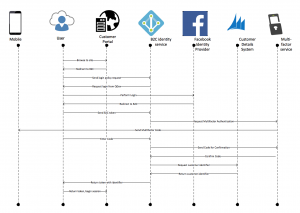In Part 1, I covered the need for control over Corporate Identity. In this, Part 2, I will cover a more emerging field of consumer identity, and relate it to opportunities in the Aged Care industry.
Aged Care is on the cusp of a revolutionary change in service delivery. Whereas it has been obvious for decades where technology can make service delivery more efficient, there is now an opportunity to interact with customers using technology.
Baby Boomers are retiring! This would not be news to anyone in the industry, in fact you would have been planning for this for a long time. What is different is that Baby Boomers are far larger consumers of digital technologies than previous generations. Also, their families are even more attuned to digital technologies such as social media.
This presents an opportunity to provide service delivery through digital channels. Although you probably wouldn’t want to rely on Facebook for a patient to request urgent care, there certainly exists the possibility of interacting digitally with patients and their families.
This could be any number of services:
- Administrative – payment of accounts, updating of personal information, consent, etc.
- Service delivery – entertainment and value add service delivery – video on demand, internet service delivery.
- Community – Social networking
- Marketing – digital marketing, registration of interest.
Consumer Identity is the field which deals with digitally identifying customers that are transacting with you digitally. This emerging field of identity, sometimes knowns as “Business to Consumer” or B2C, is getting a lot of attention in the identity industry. As well-crafted Consumer Identity can open up new markets and opportunities to maximise customer engagement, and as such has been one of a number of new technology fields that have the attention of boards of service industry companies.
The graphic above is known as a “flow diagram”, and shows a potential use of Facebook as an Identity Provider. Whilst this diagram is somewhat technical, it shows you how you coordinate the use of things people have, or use regularly, to identify someone that is using one of your services (Customer Portal). The possibilities are endless.
Consumer Identity has many of the same characteristics as Corporate Identity – governance, process and technology – with the added issue of registration, verification and privacy.
Leaving the technology aspects aside, here are some things to consider:
- With the proliferation of services on the internet, people are getting tired of having lots of different accounts, in fact this becomes a security risk as people repeat passwords. Carefully consider using well trusted Identity Providers (such as Google) instead of building your own directory of users’ authentication credentials. Google, Microsoft, Facebook and others have a massive investment in ensuring that people trust their services and spend more money than you can imagine protecting this trust. If something happens, it’s within their interests to fix it, and fix it quickly and properly.
- Whilst you can trust these Identity Providers to say that the user is the same person that you interacted with previously, you can’t trust them to provide verifiable information about people. If you need to store PII about the user, if, for example, they need to enter into a contractual transaction with you, then you will need to verify users. This process is called “Registration” or “Verification”. You will need to think carefully about how to do this.
- This identity will be the gateway to some sensitive information about your customers! You are expected to take every reasonable step to make this information private. In some cases this may even be medical records.
There are a number of vendors in this space, and in some cases the solutions are available as Cloud-based solutions – some of which do not keep information off-shore of Australia. I recommend engaging a specialist company to help you understand which solutions are best for your Aged Care enterprise. The possibilities are endless – mobile apps, tablet applications, web based information portal are only the start – and you will be able to leverage great solutions to supply innovative solutions to your patients, families, and communities.
Shane Day is the Chief Technology Officer of UNIFY Solutions, a world renowned Identity and Access Management specialist company.


Recent Comments